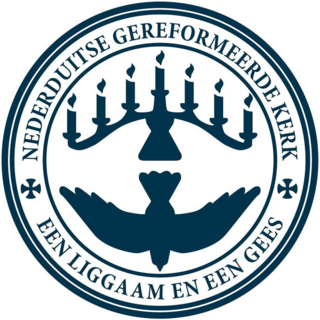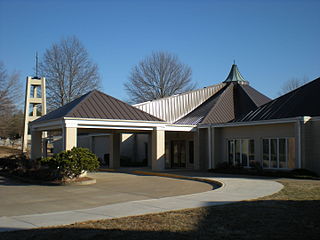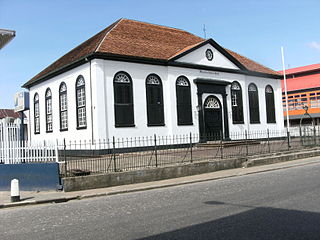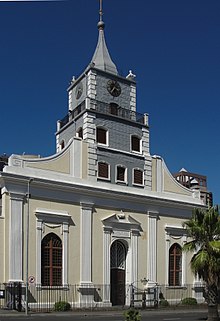
Henry Melchior Muhlenberg, was a German-born Lutheran clergyman and missionary. Born in Einbeck, Muhlenberg immigrated to the Province of Pennsylvania in response to demands from Lutherans for missionary work in the colony. Muhlenberg was integral to the founding of the first Lutheran church body or denomination in North America, and is considered the patriarch of the Lutheran Church in the United States.

Gloria Dei Church, known locally as Old Swedes', is a historic church located in the Southwark neighborhood of Philadelphia, Pennsylvania, at 929 South Water Street, bounded by Christian Street on the north, South Christopher Columbus Boulevard on the east, and Washington Avenue on the south. It was built between 1698 and 1700, making it the oldest church in Pennsylvania and second oldest Swedish church in the United States after Holy Trinity Church in Wilmington, Delaware.

The Dutch Reformed Church is a Reformed Christian denomination in South Africa. It also has a presence in neighbouring countries, such as Namibia, Eswatini, and parts of Botswana, Zimbabwe and Zambia. In 2013 it claimed 1.1 million members and 1,602 ordained ministers in 1,158 congregations.

Groot Constantia is the oldest wine estate in South Africa and provincial heritage site in the suburb of Constantia in Cape Town, South Africa.

St George's German Lutheran Church is a church in Alie Street, Whitechapel just to the east of the City of London. From its foundation in 1762 until 1995 it was used by German Lutherans. Today the small vestry serves as an office for the Historic Chapels Trust and the church is available for hire for secular events.

Greenmarket Square is a historical square in the centre of old Cape Town, South Africa. The square was built in 1696, when a burgher watch house was erected.
Anton Anreith was a sculptor and woodcarver from Riegel near Freiburg in Breisgau, Baden, Germany. He is known for numerous sculptural embellishments that adorn buildings in the Cape region of South Africa, thought to represent the crowning achievement of the Cape Baroque style.

Hanover Lutheran Church is a Lutheran congregation in Cape Girardeau, Missouri, that is a member of the Lutheran Church–Missouri Synod. The congregation's original organization came about in 1846 as a result of the heavy German immigration to Missouri in the 19th century. The church's name, "Hanover", was chosen to reflect the place of origin of the majority of its members, since many of the Germans who had settled northwest of the town of Cape Girardeau had immigrated from Hanover, Germany.

Salem Lutheran Church is an LCMS church in Farrar, Missouri.

Zion Lutheran Church is an LCMS church in Longtown, Missouri.

Immanuel Lutheran Church is an LCMS church in Perryville, Missouri.

The Groote Kerk is a Dutch Reformed church in Cape Town, South Africa. The church is South Africa's oldest place of Christian worship. The first church on this land was built in 1678. Willem Adriaan van der Stel laid the cornerstone for the church. It was replaced by the present building in 1841 built by Herman Schuette and the original tower was retained. The pulpit is the work of Anton Anreith and the carpenter Jacob Graaff, and was inaugurated on 29 November 1789. The Groote Kerk lays claim to housing South Africa's largest church organ, which was installed in 1954

Rust en Vreugd, is a historic house and garden, located on Buitekant Street at the edge of the central business district of Cape Town, South Africa. It is one of the few remaining 18th-century buildings in the city. The Rust en Vreudg is home to the William Fehr Collection of pictorial Africana. It is a part of the Iziko Museums.

St. Michael's Evangelical Lutheran Church is a historic church building in the Mount Airy neighborhood of Philadelphia, just north of the Germantown neighborhood. The congregation was founded sometime before 1728 and three successive church buildings have occupied the same location since that time. The church was closed in 2016.

The Martin Melck House on 96 Strand Street and the Kostershuis on 100 Strand Street, on either side of the Lutheran Church in Cape Town, are both national heritage sites of South Africa.
The Johannesburg East Reformed Church was a congregation of the Dutch Reformed Church in South Africa (NGK) in the Johannesburg suburb of Doornfontein, just east of downtown. It is also known as the Irene Church after the sobriquet of its second and third churches on 1 Beit Street. Five weeks before its centennial, on June 1, 1997, Johannesburg East was absorbed by the Johannesburg Reformed Church (NGK), from whence it had seceded on July 8, 1897.
The Turffontein Reformed Church was a congregation of the Dutch Reformed Church in South Africa (NGK) in southern Johannesburg, Transvaal. It was founded in 1906 and for years had a large membership, at times exceeding 3,000.

The Lutheran Church of the Ascension is a historic Lutheran church on Bull Street in Savannah, Georgia, located in the Savannah Historic District. The congregation was founded by Johann Martin Boltzius in 1741, with the current building constructed in 1843.

Maria Margaretha Koopmans-de Wet was a campaigner for Afrikaner rights, cultural leader, patriotic benefactor, renowned Cape hostess, patron of the arts and South African philanthropist.

The Martin Luther Church is a church of the Evangelical Lutheran Church in Suriname. It is located on Waterkant in the historic centre of Paramaribo, Suriname. The building is a monument. The first church burnt down in 1832. The current church dates from 1834.


















